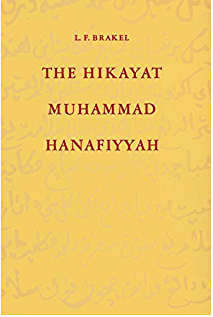The Hikayat Muhammad Hanafiyyah: A Medieval Muslim-Malay Romance
 | |
| Author | L.F. Brakel |
|---|---|
| Language | English |
| Published | 2013 |
| Publisher | Springer |
| Pages | 332 |
The book The Hikayat Muhammad Hanafiyyah: A Medieval Muslim-Malay Romance has as its background the events that took place in the second half of the seventh century A.D. with the martyrdom of Hussein and the ensuing efforts of his followers to install his sons as the rightful successors of Muhammad.
About the author[edit | edit source]
L.F. Brakel was best known for his work with the Further Reformation, which was contemporaneous with and greatly influenced by English Puritanism.
About the book[edit | edit source]
This book published in Springer; Softcover reprint of the original 1st ed. 1975 edition (November 13, 2013), has 332 pages. This book has been the author’s constant companion for much of the last nine odd years. He was more or less constantly on the move, trekking from the Nether lands to Australia and back again, then to the United States, with three excursioru; to Indonesia. On all these trips he carried his notes and kept working on this project.
Abstract of chapters[edit | edit source]
Chapter 1: The Historical Background[edit | edit source]
In this chapter the author briefly summarizes the events related to the succession of Muhammad and the resultant traditions which developed around them in the Shiite world.
Chapter 2: The Malay Hikayat Muhammad Hanafiyyah (H.M.H.) and Its Sources[edit | edit source]
In this chapter the Malay H.M.H. and its sources are discussed. As is confirmed by the Sejarah Melayu and Hikayat Aceh, the H.M.H. has always played an important role in Malay religious circles and was renowned for its power to stimulate the courage of warriors. It was one of the two hikayat read to the Malay warriors the night before the Portuguese lunched their final attack in Malacca in 1511.
Chapter 3: The Spelling and Languages of the H.M.H.[edit | edit source]
In this chapter Brakel endeavors to demonstrate that the H.M.H. shows, even in its present form, certain features of Archaic or pre-standard Classical Malay. |Meaning, that it deviates in spelling and language from the language of the Abdullah edition of the Sejarah Melayu and in general the language found in most 18th and 19th Century manuscripts. He also points out that the H.M.H. employs two different styles of lang -the hikayat and kitab style- which have clearly distinguished structural functions.
Chapter 4: Other Texts Related to the Malay H.M.H[edit | edit source]
Chapter 4 discusses other Malay texts related to the Malay HMH. Here are mentioned those Malay texts which have also been used by the compiler(s) of the H.M.H. and which partly explain the fact that the Malay H.M.H. is larger in contents than its direct Persian source. Brakel also discusses in more detail the first part of Malay manuscript, the Hikayat Nur Muhammad, which deals with the legendary history of the prophet before his mission began.
Chapter 5: The Date of the H.M.H[edit | edit source]
This chapter is limited to a discussion of the possible date of the H.M.H.’s creation using internal evidence and data. The evidence has been presented that the Persian text may well originate from the fourteenth century, while the Malay translation is not much later.
Chapter 6: The H.M.H. and the Development of Indonesian Islam[edit | edit source]
In this chapter the author discusses one aspect of Indonesian Islam on which this text may supply valuable information: the celebration of the tenth day of the Muslim month of Muharram, better known as the Ashura day. According to the evidence discussed in this chapter, Brakel may suppose that Muharram 10th was, at one stage, celebrated in Indonesia in a manner suggestive of Shia influence, including as it did a doleful memorial ritual for those slain at Karbala.
Chapter 7: The Structure of the H.M.H[edit | edit source]
In this chapter the author shows that the H.M.H. consists of two parts. Some attention is given to the fact that the first part of the H.M.H. is a maqtal. The latter is a technical term for a Shiite literary genre (hikayat) denoting a tale to be recited in remembrance of the martyrdom of Hasan and Husain.
Chapter 8: The Manuscripts of the Malay H.M.H.[edit | edit source]
In this chapter the author first lists the Malay manuscripts of H.M.H. in order to facilitate further reference, then describes them in detail.
Chapter 9: A Comparison of the Manuscripts of the H.M.H.[edit | edit source]
After examining the manuscripts of the H.M.H. in this chapter, the author presents some evidence of philological activity on the part of the scribes.
Chapter 10: Principles of the Text Edition[edit | edit source]
Here the author mainly discusses two aspects of the present edition: the selection of the MSS of the H.M.H. on which it is based and the arrangement of the Critical Apparatus.